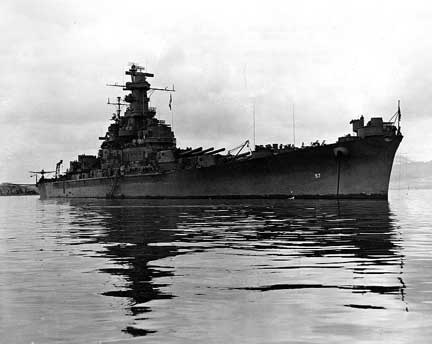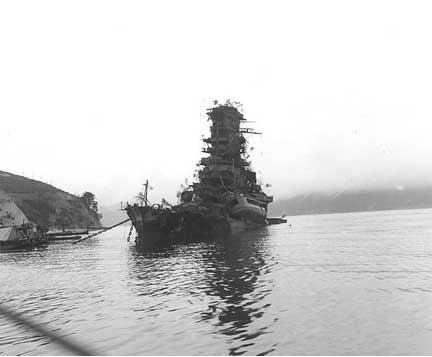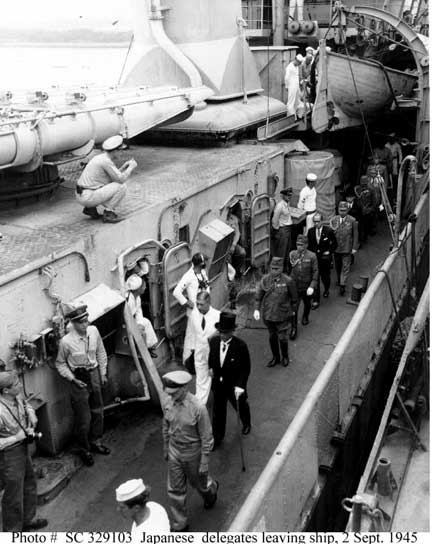
(USS South Dakota, (BB-57) in war colors as Flagship of the Pacific Fleet Commander, Fleet Admiral Chester Nimitz. Official Navy Photo).
I was going to write about cars this morning- it is the time of the season when the people with whom I share the mad eccentric passion for the wheels of yesterday are out and rolling. But this date is also something significant on the life of the Republic and the world.
On this day in 1945, an official announcement of Japan’s unconditional surrender to the Allies is made public to the Japanese people. It was not VJ Day, that is tomorrow, celebrated here on this side of the Date Line. But it is the day the Japanese war cabinet decided to throw in the towel, and I will let the vanquished express the anguish before turning my attention to the last man I will ever know who lived this.
The timeline is a little jerky: the War Council, urged by Emperor Hirohito, had submitted a formal declaration of surrender to the Allies on 10 August, though fighting continued between the Japanese and the Soviets in Manchuria, and between the Japanese and the United States in the South Pacific. Two USN ships, the Oak Hill (LSD-7) and Thomas F. Nickel (DE-587) were sunk by IJN submarine attacks east of Okinawa.
In the afternoon of August 14, Japanese radio announced that an Imperial Proclamation accepting the terms of unconditional surrender drawn up at the Potsdam Conference would be broadcast by the Emperor. The news was not met with universal acceptance. More than 1,000 Japanese soldiers stormed the Imperial Palace in an attempt to find the proclamation and prevent it from being given to the Allies. Soldiers still loyal to Emperor Hirohito held them off.
That was then. This morning, the Japanese continue to honor 14 August as the day their world changed forever. Prime Minister Shinzo Abe said that Japan’s past “heartfelt apologies” for World War II will remain unshakeable in the future. He went on to express “profound grief” for all who perished in the war and acknowledged that Japan inflicted “immeasurable damage and suffering” on innocent people.
Abe’s statement included these words: “On the 70th anniversary of the end of the war, I bow my head deeply before the souls of all those who perished both at home and abroad. I express my feelings of profound grief and my eternal, sincere condolences.”
All that said, he noted that more than 80 percent of the country’s population was born after the war and had nothing to do with the war. I don’t know if he is serious about the notion that generations who are not responsible for the bloodbath be condemned to continually apologize to people who also were not there.
I will probably never again know someone who was there and lived the events that transformed the world, but I was lucky enough to have one of the best friends a guy can have. That is why I turn back this morning to the same week five years ago, and sitting at Willow with a Great American, one of a generation whose like we may not see again. We were with Mac Showers, and the memories flood back with the breath of August in Washington, and the cool darkness of the Willow Bar:
The bill was paid, and people were starting to drift out of the bar area and over to the restaurant side of Willow. It was Restaurant Week, after all, and the prie fixe menu with choice of appetizer, entrée and dessert for $35 bucks is an attractive deal. Tracey O’Grady is always trying innovative things at Willow, and that is one of the reasons it is so much fun.
We need some fun. It could be that the recession is finally going to come to Arlington, which has ignored it thus far. At least the Defense sector has, what with two or more wars running through the decade. “Secretary Gates says he is going to retire next year, and take the national security succession issue out of the Presidential equation,” I said.
Mac was straightening the stack of books and papers he had brought to the bar to aid the discussion. “He has done a fine job. One of our better Secretaries, in my judgment, and I have seen them all come and go, from James Forrestal on.”
“It sure was a different world,” I mused, looking at the empty wine glass in front of me. “I heard the Chinese are asserting sovereignty over the Senkaku Islands west of Okinawa.”
“Oil, I would imagine,” said Mac. “The islands were part of the U.S. military mandate that we gave back to the Japanese in 1972 along with Okinawa. The Administration doesn’t seem to have the grit to explicitly tell the Chinese that they are Japanese territory, and subject to the provisions of the mutual defense treaty.”
“I guess we don’t want to irritate the Chinese,” I said. “But it seems like we are going to look like a Paper Tiger. If we cut carrier strike groups in the defense retrenchment, and the ASEAN nations are afraid to let us land-base the Air Force in Asia, what the hell do we think we have as a credible threat? Send a couple carriers against the whole of China?”
“Certainly is a policy conundrum,” said Mac. “It is a complete circle from 1940, only with Japan playing the role of today’s China. Article 5 of the 1960 “Treaty of Mutual Cooperation and Security” with Japan states clearly that it specifically applies to the Senkaku Islands. Try as Secretary Clinton might to soft pedal things, it is hard to get around that.”
“It seems like we are surrendering the issue without discussion,” I said. “Like when the Japanese strafed the American gunboat Panay on the Yangtze River after the Rape of Nanking in 1937.”
“Yes indeed. And we did not respond, and four years later, the Fleet was on the bottom of Pearl Harbor. Take your stand, put up your dukes. It is pay me now or pay me later.” Mac leaned forward. “I will give you a last story before we go.”
I picked up my pen and flipped to a clean page on the note pad I lifted from the US Senate years before.
“Eddie Layton was one of the few guys who saw the beginning and the end of the war, said Mac quietly. “He started it in Admiral Husband Kimmel’s office on the day of the attack. It is quite a professional tribute to his abilities that Admiral Nimitz took him along as his personal guest to the Surrender in Tokyo Bay. Eddie actually masqueraded as his bodyguard and carried a pistol. As a member of the Pacific Fleet Commander’s official entourage, Eddie was quartered in USS South Dakota, (BB-57).”
“She was a battle wagon,” Mac continued “New construction in 1939, and she had thirteen battle stars before it was all over. Seven hundred feet long and bristling with guns, she carried twenty-four hundred officers and men, plus the embarked staff, if there was one. She had a Panamax beam on her, built to within inches of fitting through the locks on the Canal, so she was roomy and the wardroom was vast.”
“I have been in the wardroom on Alabama, one of her sister ships,” I said. “It was a lot different than the carriers I rode. Stately. I think they had cutlass racks on the quarter deck.”
“They probably did. It was a the continuation of an old tradition, carried almost to the ultimate level that the four Iowa-class battlewagons represent. Halsey was embarked in Missouri in Tokyo Bay for the surrender, and Admiral Nimitz took South Dakota as his.”
Mac chuckled. “She was a ship that set a unique record. A twelve-year-old managed to sign up for the Navy after Pear Harbor, and he actually got assigned to her in time for the battles in The Slot. He was wounded, too. Calvin Graham was his name,” Mac said with satisfaction. “You can look him up. He wound up getting a Big Chicken dinner- a bad conduct discharge- when his Mother disclosed his real age.”

(Collapse of Japan. The rebuilt battle cruiser Haruna was sunk at her moorings in the naval base of Kure on 24 July, 1942. Official Navy Photo)
South Dakota had the same sort of wild change of circumstance that everyone did. In early August she was shelling northern Honshu and supporting carrier strikes against Tokyo, right up to the last surface action of the War on the 15th of August. On September 2nd, she was anchored in the Sagami Wan with Admiral Nimitz and his guests on board.”
“Eddie told me about it later. He was not senior enough to see the ceremony, but he said it was honor enough to be there. Following the signing of the instrument of surrender, the Allied delegates and spectators began to leave Missouri. General MacArthur boarded a destroyer to be transported back to Yokohama. Admiral Nimitz left by boat after that and was soon back on board South Dakota. Halsey stayed on his flagship, and enjoyed a conversation with his old friend, VADM John S. McCain, who would die of a heart attack just four days later. That would be Senator John McCain’s grandfather.”

“Stress,” I said. “Pity to live just long enough to see the end of it, and not the beginning of the new world.”
Mac nodded. “So here is where it gets interesting. Eddie Layton was playing acey-duecy in the wardroom of South Dakota when Admiral Richmond Kelly Turner strode into the room. “Terrible” Turner was in a state of high excitement. He was another of Admiral Nimitz’ personal guests. He executed all the amphibious landings in the Pacific, from Guadalcanal to Iwo Jima, after all. But he was a son-of-a-bitch to his staff, and liked the bottle. Eddie said he was pretty fired up that evening. He started to shoot his mouth off, and the wardroom hushed at the remarkable sound of the inebriated four star’s booming voice.”
“What was he saying?” I asked.
“He was going off on Admiral Husband Kimmel, of all things. Something to the effect that “Goddamned Kimmel had all the information and he didn’t do anything about it. The court of inquiry said so, and they ought to hang him up higher than a kite!”
“But it was Turner himself who did not allow the critical Bomb Plot messages go to Pearl Harbor!” I exclaimed. “He must have known that. The court of inquiry was a white-wash to scapegoat Kimmel and General Short.”
“Eddie sat there, stunned at what he was hearing. He had been there at the beginning, and was with Kimmel in the attack. Here at the end of it, the architect of the disaster was shouting that Kimmel ought to be hung up by his fingernails.”
“I guess you can’t do anything against four stars,” I said thoughtfully, trying to imagine the scene with any of the other four-stars I have known in my life.
“Well, Eddie got pretty fired up, too. He corrected Turner in mid-rant. He told the Admiral that he had been there as Kimmel’s intelligence officer, and he had been there in person on December 7thyh, 1941.”
“So what happened?”
“Eddie said the Admiral charged across the deck and grabbed him by the throat. Eddie was putting his dukes up to pummel the Admiral when the skipper of South Dakota, Emmet Forrestal, got in between them and broke it up.”
I looked at Mac with amazement. The idea of decking a four-star Admiral made me admire Eddie Layton even more.
“Why on earth did Admiral Nimitz put up with Turner?” I said. “The man seems to have been unstable, and even if his war record was good, his poor judgment at the beginning is what contributed to bringing on the disaster.”
Mac looked at me thoughtfully. “Admiral Nimitz always believed a man should get a second chance, since he got one himself as a young officer. Turner got his second chance after he screwed up in War Plans before the war. The cover-up of the whole ugly matter split a generation of senior officers and fueled a political and historical controversy over who was to blame for the Pearl Harbor disaster.”
“Not to mention that fact that the war over who controls Signal Intelligence has continued right down to this year. We even had different officer designators for the Cryppies and the Intelligence officers, and never the twain did meet until sixty-five years later.”
“I could have been either,” said Mac, gathering up his papers. “But of course, that is another story.”
Copyright 2015 Vic Socotra
www.vicsocotra.com
Twitter: @jayare303
